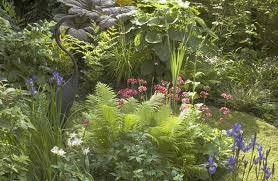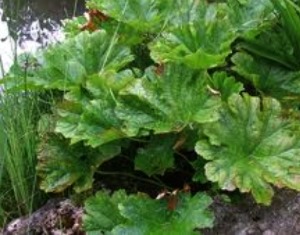





A wide range of interesting plants, which cannot normally be cultivated elsewhere, can be grown in a bog garden. It is a natural adjunct to a water garden, neatly linking the pool to the surrounding garden and providing great opportunities for extending the season of plant interest.
 Many of the plants that are popularly grown in bog gardens can often be seen in mixed or herbaceous borders, but unless they happen to be growing in damp spots, they will be mere shadows of their true selves. Daylilies, or hemerocallis, revel in wet soil, along with astilbes and hostas. There are even bulbs that love damp conditions, such as the summer snowflake and the quamash, or camassia. All give a peak performance in a richly-organic wet soil.
Many of the plants that are popularly grown in bog gardens can often be seen in mixed or herbaceous borders, but unless they happen to be growing in damp spots, they will be mere shadows of their true selves. Daylilies, or hemerocallis, revel in wet soil, along with astilbes and hostas. There are even bulbs that love damp conditions, such as the summer snowflake and the quamash, or camassia. All give a peak performance in a richly-organic wet soil.
Conversely, some of the plants that are grown as marginal subjects will adapt to bog garden conditions. Marsh marigolds always look more robust when growing in damp soil, rather than standing water, while water forget-me-not and brass buttons are equally content in the bog garden. Some plants, however, are specifically bog garden dwellers: for example, the brightly coloured candelabra primulas, the clematis-flowered iris of Japan and the umbrella leaf.
For the majority of gardeners, the main objective with any feature is to achieve season-long colour and interest, and a bog garden is no exception. Here, the aim is easier to achieve than with a pool, for woody plants are available that provide year-round height and structure, as well as winter colour.
The coloured-stemmed cornus are classic examples, producing bright red, purple or yellow stems that sparkle in the winter sunshine. Provided that they are cut down each season just before they burst into leaf, they will come up trumps every year. The same applies to some of the willows, not the large weeping types, but wonderful restrained characters with bright upright stems.
Sprinkle the ground around such plants with Primula rosea, a very early spring flowering primula, much like an exotic, iridescent pink primrose. This makes a contrast with the colourful stems just before they are pruned, and provides a convenient link with the short growing double marsh marigold (Caltha palustris ‘Fiore Pleno’). Although grown primarily in the margins of the pool, it will make a lovely golden hummock in the spring bog garden.
 The umbrella leaf (Peltiphyllum peltatum) also associates well with marsh marigolds. Its globular heads of rose-pink flowers, borne on naked stalks, wander across the bog garden by means of stout rhizomes. These smother the fading remains of early flowered subjects with green and bronze leaves as spring turns to summer, but rarely cause them any harm. As their leaves unfurl, the undoubted stars of the bog garden burst into flower.
The umbrella leaf (Peltiphyllum peltatum) also associates well with marsh marigolds. Its globular heads of rose-pink flowers, borne on naked stalks, wander across the bog garden by means of stout rhizomes. These smother the fading remains of early flowered subjects with green and bronze leaves as spring turns to summer, but rarely cause them any harm. As their leaves unfurl, the undoubted stars of the bog garden burst into flower.
Hot on the heels of the lilac, blue or white drumstick primulas come their candelabra counterparts. Few late spring or early summer displays can surpass the sight of their tiered whorls of blossoms. Plan to grow these easy-going plants in a way that will permit self seeding, not crowding them with other plants, but planting in groups of the same variety so that they form spreading colonies.
Such planting schemes can look bold and strident on their own, so it is a good idea to soften them with foliage. The moisture loving ferns are ideal for this, especially the, ostrich feather fern (Matheucia struthiopteris) with its pea-green, fiddle-like heads, which transform rapidly into luxuriant shuttlecocks. The sensitive fern (Onodea sensibilis) creeps and forms a pale green understorey, but starts off rose-pink as the fronds unfurl. It spreads harmlessly among clumps of perennials, tumbling over the poolside into the water.
For a focal point of architectural foliage there is the majestic royal fern (Osmunda regalis), a giant of a plant with handsome bright green fronds that turn bronze at the first hint of frost. This looks superb at the water’s edge, its regal presence being reflected in the still clear water.
However, the most magnificent foliage effects in the bog garden are created by hostas, such is their diversity of colour and stature. Formerly referred to as plantain lilies, in recent years, these-easy-going plants have enjoyed a cult following, but justifiably so, for their handsome broad leaves and occasional striking flowers make them some of the most versatile plants for wet conditions. They look best when planted in groups or drifts, as few as three plants of a kind producing a pleasing effect, Their exotic appearance can be used to suggest a tropical environment.
A bog garden will be a tremendous asset, particularly when developed as an integral part of a water garden. However, even without an accompanying body of water, it can become a valuable feature in its own right.
Copyright © www.100flowers.win Botanic Garden All Rights Reserved